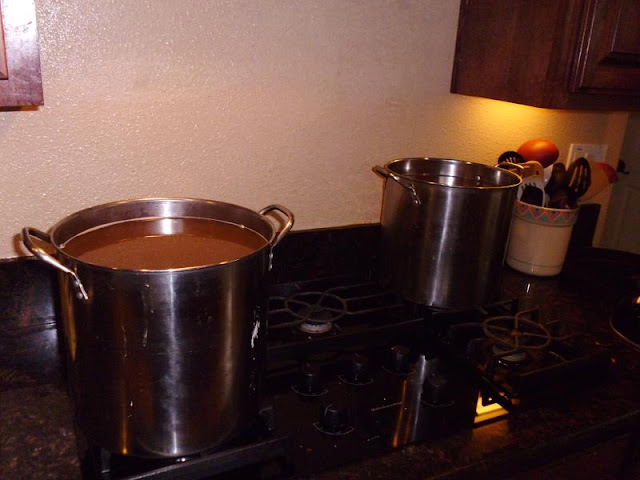 |
| Let's get this batch boiling! |
(Continued from Part 1)
The boiling plan from here on out was to set aside half of the wort in storage vessels (buckets) and boil and add hops to the other half of the wort (Sublots #1 and #2). I planned for a 60 minute boil, so leaving the wort sitting outside for that time should not affect any flavor or cause any infection.
 |
| Wort storage waiting for available kettles |
To meet my target of 2 lbs of honey total in my batch, each kettle would receive 0.5 lbs. I used some of the warm water and burner heat to make the honey easier to pour, but it remained a sticky and viscous solution to pour.
 |
| Precisely half a pound. |
 |
| Extremely viscous honey! |
The hop schedule was divided in the same way. I planned for this to be on the lighter side with more of a malt/honey flavor, so only 2 oz of hops went into this batch in total
 |
| Away it goes! |
One of my burners tends to boil up the wort fast than the other, so one kettle finished with 15 minutes left on the other to spare. In that time, I was able to get the kettle cool enough to where I could safely store the boiled wort in the fermenter. The amount of time needed to boil up the second sublot should be enough to bring it to a reasonable pitching temperature.
 |
| Chilling the first kettle |
 |
| Finishing up kettle #2 of sublot #1 |
I wanted to get my 2nd sublot started as quickly as possible once sublot #1 completed. To free up the second 4 gallon kettle, I used my 3 gallon kettle as a cooling vessel. Not only did this free up both kettles, it also prevented me from having to chill the exterior of the pot, likely saving me some reheating time.
 |
| "Dedicated" wort chilling vessel |
 |
| Boiling sublot #2 while sublot #1 cools |
With sublot #1 out of the way, it was time to move onto boiling sublot #2. Sublot #1 completely filled one of my fermenters (5 gallons total). My plan is to divide that wort up between both fermenters equally to keep a consistent gravity between the vessels.
 |
| Looks like my target boil volume was on point with sublot #1! |
When pouring in the wort for sublot #2, nearly 1.5 gallons of wort could not fit into my two main kettles. I had to fire up the third burner and attempt to boil off as much as possible. To help with this, I extended the total boil time of each kettle to 90 minutes. The hops were added in on the normal schedule (60 min, 30 min of boiling remaining).
 |
| Kettles firing on all cylinders! |
When sublot #2 finished boiling and cooling, it was time to load up my fermenters.
I soon discovered that I had a variance on my hands; I ended up with 12 gallons of wort. Normally, overshooting the target volume of 10 gallons of beer does not happen. I took action and brought out my two glass 1 gallon carboys to contain and ferment the excess.
 |
| Getting the wort evenly distributed here |
The most surprising thing aside from the excessive wort volume was the fact my composite wort sample for my original gravity showed I still hit my target. (
OG: 1.050) I think the honey addition sweetened my target just enough.
 |
| That's a lot of beer! |
I'm hoping this thing ferments down to make this batch have 5% ABV. I installed airlocks on all my fermenters since I'm betting my gravity is below the blowoff threshold. You can never trust Burton Ale Yeast though. If it starts blowing off, I'll install blowoff tubing.
This is also the first time I'm fermenting in my garage. It's likely it will be colder out here during the night, which should help keep the yeast under control. Then again, between the day and the night, the temperature will likely fluctuate with the weather outside. We'll find out how this beer ferments soon. Until then, cheers!
"916" (10 gallon batch size)
13 lbs 2-Row
2 lb Honey Malt
1 lb White Wheat
1 lb Flaked Wheat
2 lbs Clover Honey
1 oz Norther Brewer (60 min)
1 oz Fuggles (30 min)
WLP023














No comments:
Post a Comment
Hi folks, please only leave comments relative to the blog post. All spam will be removed and spammers will be blocked.
Note: Only a member of this blog may post a comment.